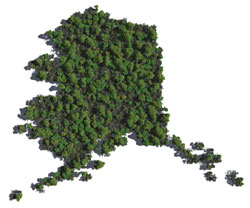RE:
SEARCH
Arctic exploration
Researchers examine Alaskan tundra for insight into climate warming

raduate student Carol Moulton loves Alaska in the summertime. It’s a temporary manifestation of happiness—a place where the sun literally shines all day. Beginning with summer solstice, when every part of the nation’s most mammoth state gets a full 24 hours of sunlight, the phenomenon usually lasts until early August.
Over the years, the Home of the Midnight Sun has become a popular vacation destination. Moulton, however, comes for more than the view. She comes to conduct research. In addition to being a major tourist locale, Alaska is a mecca for those who study arctic biology.
Last summer marked Moulton’s third journey to Toolik Field Station in the northern foothills of the Brooks Range, 254 kilometers north of the Arctic Circle. Toolik is a research hub run by the Institute of Arctic Biology at the University of Alaska Fairbanks.
It was Moulton’s first trip to Toolik without her adviser, biology Associate Professor Laura Gough, but she continued to work on Dr. Gough’s project—a study on long-term ecological research (LTER) plots. Moulton took percent cover data to estimate the abundance of plant species from two types of tundra, moist acidic and dry heath.
Gough is exploring whether factors like herbivory and nutrient addition have an effect on the tundra and how they relate to climate warming in the region. Studies have shown that warmer arctic soils produce more nutrients that cause greater plant growth, so long-term nutrient addition experiments are used to understand this process.
Moulton and Gough outlined the work to be accomplished before the trip.
“I’ve done many jobs where I worked without my adviser or the principal investigator of the project around, and I’m comfortable making my own decisions,” Moulton said. “However, I knew that if I had issues or problems I couldn’t solve myself, Dr. Gough was just an e-mail or call away to discuss matters.”
- biology graduate student Carol Moulton
Moulton also began her own project, exploring whether sexual reproduction of plant species in the dry heath tundra is affected by the herbivory by small animals or added nutrients.
To test this, she is counting seedlings, flowers and fruits in the dry heath, as well as placing artificial turf to collect seed dispersal. She will then take the data back to UT Arlington to conduct a seed bank experiment to check for germinating seeds. She hopes to find a relationship between nutrient addition and seed production, suggesting that climate change may affect the ability of these species to reproduce.
Workdays were long at Toolik. After an 8 a.m. breakfast, Moulton and her field assistant would review plans, grab their field gear and hike to the LTER plots. Depending on the weather—sunny in the morning, rainy or cold in the afternoon—they ate lunch in the field or back at the Toolik cafeteria.
They continued in the field until dinner at 6 p.m. After dinner, they would enter the day’s data, then head to bed or relax with other researchers. Sunday was their only day off.
A self-described “biophile,” Moulton hails from Massachusetts and received a bachelor’s degree in ecology at Unity College in Maine in 2004. She participated in the Research Experience for Undergraduates program in plant biology at the University of Massachusetts Amherst.
“I’ve been interested in plants since I was very young,” she said. “As I continued working in the field after graduating, I realized I wanted to work in ecosystems that may be affected by climate change, particularly arctic and alpine ecosystems.”
That desire brought her to UT Arlington. While browsing the Ecological Society of America’s job board, a posting by Gough concerning arctic plant community ecology caught her eye. She was so fascinated with Gough’s research that UT Arlington was the only school to which she applied.
Gough was equally enthusiastic.
“Carol has worked with some excellent ecologists in different labs across the country, and her supervisors all said great things about her,” Gough said. “I also could tell that she loves ecology and loves being in the field, two critical characteristics for students who work with me and particularly for students who work at Toolik, since it is not a very easy place to be at times.”
Gough plans to join her graduate student at Toolik this summer as they continue to look for connections between plant life and climate warming.
— Camille Rogers
Other Stories
Deep thinkers
Pilot projects encourage students to take charge of their own learning
Mavericks Personified: Wajiha Rizvi
Recent graduate takes a campaign detour
Family Friendly
Dan and Grace Cruz never dreamed they'd one day attend college alongside sons Mike and Nick. It's hectic but worth it, they all say.
Arctic exploration
Researchers examine Alaskan tundra for insight into climate warming
What’s in a name?
Building namesakes include former presidents, deans, coaches and an astronaut
Contact Us
Office of University Publications
502 S. Cooper St.279 Fine Arts Building
Box 19647
Arlington, TX 76019-0647
